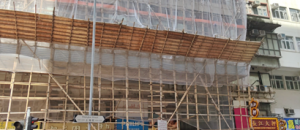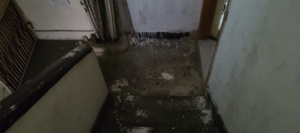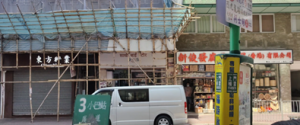My video link: https://www.youtube.com/watch?v=8cjIUSFPX-U
TONG LAU —— THE FADING HERITAGE
Introduction:
Tong Lau are tenement buildings in Hong Kong built from the late 19th century to the 1960s. However, due to urban development, most of Tong Lau buildings have been demolished. This video aims to investigate the phenomenon of and reasons behind the disappearing of Tong Lau in Shanghai Street, and its consequences of the potential loss of Hong Kong’s cultural heritage.
Tong Lau, the traditional tenement buildings of Hong Kong, are rapidly disappearing for several reasons according to some online research and interviews in the field trip. Firstly, urban development has played a major role in their demolishment. As Hong Kong modernized and expanded, old structures like Tong Lau were often viewed as less economically viable and were demolished to make way for taller apartments and commercial buildings. The government has implemented some policies that prioritize high-rise developments which further contributed to the demolition of Tong Lau. Secondly, the aging infrastructure of Tong Lau buildings has made them incompatible with modern standards and lifestyles. Many Tong Lau structures were built over a century ago and struggle to meet contemporary building requirements. This is evidenced by the collapse of a Tong Lau building at 45 Ma Tau Wai Road in 2010, emphasizing their vulnerability due to structural instability.
These buildings have served as vessels of memories for old Hong Kong residents, standing as silent witnesses to the passage of time and the rich tapestry of human experiences. They are a testament to the interconnection of people’s heart. The disappearance of Tong Lau may be a huge loss for the city, the fading of cultural bonds and diminishment of the city’s unique heritage.
Methods:
To look deep into the disappearance of Tong Lau, various research methods were applied, including historical research (read relevant articles published online), field trip and interviews. In the field trip, I went to Shanghai Street in person and was closely exposed to the view and vibe of Tong Lau. By close observation of the inner and outer space, I gained a deeper understanding of the reason of their demolishment and their status quo. I also conducted several interviews with some residents nearby to gather detailed and specific information and gain insights that may not be available through other data collection methods.
Methods of producing the video are shown scene by scene as follows:
Scene 1

The shot follows a person walking along the pedestrian. A close, walking-like shot is used, showing the warm and lively ambience of the stores on the ground floor of Tong Lau. The viewers can easily identify with the character in the video, as if they themselves were witnessing the scene. This angle and moving provide the viewers with an immersive experience to feel the sense of identity and belonging.
Scene 2

The shot is a wide shot, eye-level to low angle. This shot is used to clearly demonstrate the whole picture of Tong Lau and the status quo of its disappearing, where there are some scaffolds and workers outside Tong Lau. The eye-level to low angle indicates that the building is not tall even when shot from the ground.
Scene 3

The shot is a close shot, high angle. The camera is following the character walking downstairs, with dim light, dilapidated walls, and dust in the corner. Having a close shot at the character’s back is to make viewers more easily related to the scene. Using a high angle, which points to the lower place, offers a feeling of going into the darkness, which strengthens the vibe of dimness and oldness.
Scene 4

Dolly Zoom is used. It alters the relationship between the subject and the background, creating a distorted perspective. As the camera zooms out, the subject remains relatively the same size, while the background expands, creating a surreal and unsettling visual effect. It adds depth, tension, and visual impact to the scene, leading to the warning of the future if Tong Lau totally disappear, and raising viewers’ awareness and reflection of this precious heritage.
Conclusion
Due to the urban development and Tong Lau’s aging infrastructure, Tong Lau are likely to disappear in the future. As Tong Lau is disappearing, Hong Kong’s traditional memory and culture is also disappearing.
Reflection
The colour and light of filming could be improved. For example, the light could be dimmer and the colour could be darker in the scene of ‘stairs’. This needs better skills of filming and a better filming equipment than an iPhone. There could be more interviewee involved to make the research more convincing. But it is not bad for a beginner.
Reference
Lai, L. W. C. (2018). What is a Tong Lau?: I know, as i lived in one… Journal of the Royal Asiatic Society Hong Kong Branch, 58, [208]-217. https://search.informit.org/doi/10.3316/informit.019607590580213
Yin, L. H. (2010). Pre-war Tong Lau: A Hong Kong Shophouse Typology. Resource Paper for the Hong Kong Antiquities and Monuments Office, Hong Kong Development Bureau. Commissioner for Heritage’s Office, 19, 1-17.
Ng, S. L., Zhang, Y., Ng, K. H., Wong, H., & Lee, J. W. Y. (2018). Living environment and quality of life in Hong Kong. Asian Geographer, 35(1), 35-51.
Lee, H. Y., & DiStefano, L. D. (2016). Tong Lau: Hong Kong’s Anglo-Cantonese Shophouse Typology. Shophouse/Townhouse: Asian Perspectives.
HK Magazine. (2013, November 28). What is a Tong Lau? South China Morning Post. Retrieved from https://www.scmp.com/magazines/hk-magazine/article/2035876/what-tong-lau
South China Morning Post. (2022, September 2). Vanishing Tong Lau: Hong Kong heritage experts call for action. Retrieved from https://www.scmp.com/news/hong-kong/society/article/3191243/vanishing-tong-lau-hong-kong-heritage-experts-call-action
SCMP Editorial. (2022, September 11). Tong lau are part of the fabric of the city. South China Morning Post. https://www.scmp.com/comment/opinion/article/3192088/tong-lau-are-part-fabric-city
Cheung, T. (2019, June 16). Upstairs, downstairs: How Hong Kong’s historic tong lau tenement buildings are making a comeback as hipster hang-outs. South China Morning Post. https://www.scmp.com/news/hong-kong/health-environment/article/3014526/upstairs-downstairs-how-hong-kongs-historic-tong
Colliers. (n.d.). New homes and old homes. Colliers. https://www.colliers.com/en-hk/news/new-homes-and-old-homes
Slater, N. (2020, July 3). How Victoria Allan transformed a tong lau into a modern apartment complex. Hong Kong Living. https://hongkongliving.com/victoria-allan-tung-fat-building/
Shao Boning
3036127373